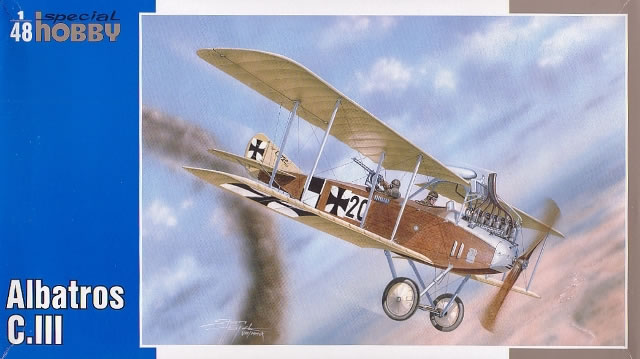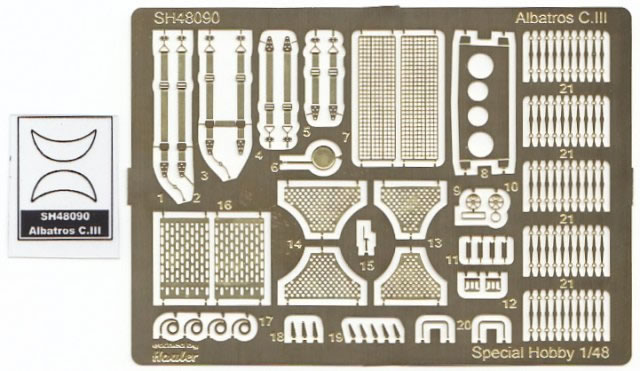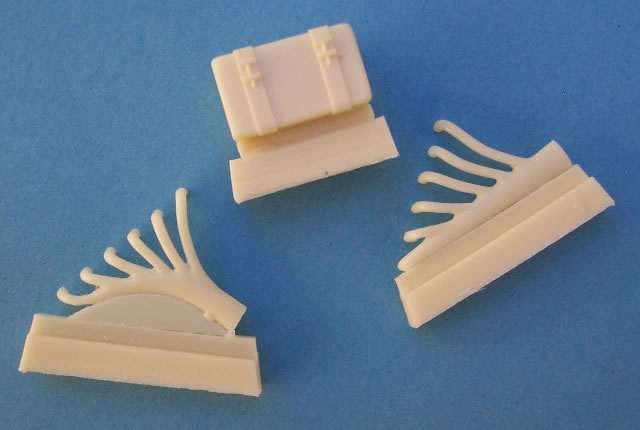|
Albatros C.III

Special Hobby, 1/48 scale
S u m m a r y : |
Catalogue Number: |
Special Hobby Kit No. 48090 - Albatros C.III |
Scale: |
1/48 |
Contents & Media: |
77 light grey plastic parts on two sprues, 6 clear parts on one sprue, 17 resin parts on eight pour blocks, 30 PE parts on one fret plus decals for 3 aircraft and a 10 page instruction booklet with history, parts plan, 14 construction steps and three pages of paint/decal instructions. |
Price: |
35 EUR available online from CMK Kits Shop
£21.87 available online from Hannants
USD$39.20 available online from Squadron
|
Review Type: |
First Look |
Advantages: |
Competent plastic mouldings; inclusion of resin and photo-etched parts; excellent choice of markings; decals in perfect register with thin carrier film. |
Disadvantages: |
Overwing gravity tank omitted; no decals for the instruments. |
Conclusions: |
The Special Hobby Albatros C.III will easily make up into a fine replica. Good use is made of the different media in the kit and the breakdown of parts will ensure trouble-free assembly. |
Reviewed
by Rob Baumgartner

Special Hobby's 1/48 scale Albatros C.III is available online from Squadron.com
The Albatros C.III is one of the best known of the German two-seaters.
It was a proverbial workhorse for the German Air Service and soldiered on from 1915 to the end of the war. As such there were no less than eight manufacturers involved in its production which meant a variety of differences between aircraft. This can best be seen in the styles of exhaust, louvre arrangements, armament and flying surfaces.
Contents
Seventy five plastic parts are contained on the grey coloured sprues. The mouldings are excellent with plenty of sharply defined detail and virtually no flash. This is complimented by a fret of photo-etched parts and a bag of resin goodies.
The only items requiring immediate attention were the landing gear struts and the radiator. The tips of the former exhibited a couple of minor sink marks but fortunately these can be easily filled without any loss of detail. Not so lucky was the radiator which displayed a multitude of depressions. To save the day, the box contained an alternative grill in the form of an etched metal part. This solves the problem quite nicely.

Construction starts conventionally with the cockpit area. The usual suspects are present such as the seats (folding for the observer), steering column and wheel (includes gun firing trigger), rudder, pressure pump, bulkheads and instrument panel. This latter item features all the appropriate switches on the right hand side as well as the thermometer, and rpm counter on the left.
The instrument faces are represented as a “blank canvas” in this release. So unless you have a steady hand, the options are to source a set of decals or scrounge a fret of coloured photo-etched items.
A hand brake can be added to “busy-up” the cockpit, as can a greaser, magneto and throttle. The floor contains the holes for dropping the bombs and these are detailed with p-e that can easily be rolled up into the appropriate perforated chutes.
This material also takes care of the seatbelts although one would expect to see lap belts rather than the provided harnesses.
The resin comes into its own in the next assembly sequence. Here we get a choice of exhaust styles that attach to the six cylinder engine. Either the 160hp Mercedes D.III or 150hp Benz Bz.III were fitted to these aircraft. Much of it sits above the fuselage so the detailer may want to add some additional pipe-work and wiring to complete the effect.

The machine guns come in for special treatment as they are blessed with fretted jackets. This includes the rear mounted weapon which shares the “Spandau” jacket of its forward firing companion. This is to represent the larger casing around the barrel of the Parabellum before the arrival of the lighter late model lMG 14/17.
It sits atop the separate rear turtle deck, which fits well enough, providing a little dry fitting is exercised first. The manufacturers should be applauded for supplying the gun-ring as a separate part as this eliminates any nasty seams.
The struts all have positive location points so assembly is very quick at this stage. The wheel covers are separate from the tyres and this greatly aides the painting process. Some clear film is supplied for the windscreen and a myriad of p-e turnbuckles will add some finesse for those brave enough to use them.
It’s a nice touch though.
A rigging diagram is included on the instruction sheet which clearly shows where every wire should go.
The major components were compared against the plans found in Albatros Datafile No.13 (revised 1999 edition). These matched the general arrangement drawings of Ian Stair in most areas with only the wings showing a marked difference. Don’t be too alarmed by the perceived lack of length as two different versions were produced. Those represented in the aforementioned plans cater for the longer spanned option.
Speaking of wings, the trailing edges are a credit to the manufacturers. They are wonderfully thin, as well as being consistent over their entire length. The representation of the upper ribs are a lot heavier than we’ve come to expect these days and some may choose to reduce them. Each aileron is a separate entity and it’s pleasing to see that allowances have been made for the actuators as well. All one has to do is make sure that the characteristic “washout” is included.
One strange omission in this kit is the overwing gravity tank. It’s illustrated on the boxtop as well as the enclosed painting guide, but sadly not on the sprues.
Marking Options
Three different schemes are contained on the decal sheet.
- Albatros C.III, C.722/16, Kampfgeschwader IV, Staffel 20, 1916.
- Albatros C.III, C.106/16, Unit unknown, 1916.
- Albatros C.III, C.736/16, Unit unknown, 1916.
The decal sheet is well printed with each item in perfect register.

The carrier film is commendably thin, yet strong enough to sustain the usual handling required to get them properly positioned.
Although its career wasn’t as distinguished as other two-seaters, the Albatros C.III still remains a favourite amongst WWI modellers.
Special Hobby has provided the enthusiast with an excellent package. It combines plastic, resin, and photo-etched parts to enable a fine replica to be built of this famous German workhorse.
Thanks to MPM for this review sample.
Text Copyright © 2010 by Rob Baumgartner
This Page Created on 18 May, 2010
Last updated
18 May, 2010
Back to HyperScale
Main Page
Back to Reviews
Page
 |
